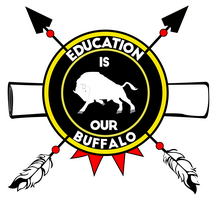Alíksai! At a certain place the Navaho were living. They were going to have a dance at some place towards the north, so they gathered together their ponies and early in the morning they dressed up. The women did not have calico dresses, but wore blue dresses with red borders and silver belts. So when they were all dressed up they mounted their ponies and went to the dance. There were a great many of them. A very heavy dust rose from all their ponies as they traveled on. They went to a place in the large canyon, somewhat north of where Fort Defiance now stands.
Towards evening they arrived at the place where the dance was to be. It was in a very deep canyon. They had to go down a steep, dangerous, zigzag trail. The Navaho lived well there; they had good homes and near by some peach orchards. During the night they had their dance. They had prepare-d a great deal of food of different kinds of meat, and thus they were eating, and during the night they had their Katcina dance. There were a great many Katcinas that had masks on. The people were camped in a circle and had camp-fires, and in the center of the circle was the dance. When they were performing the fifth dance a light was seen in the distance and a big star was rising that came down and fell down near the line of dancers, right in front of the head dancer.
The Navaho are very much afraid of something happening, so when his star fell down they all jumped on their ponies and began to scatter. Hereupon a great noise was heard west of the camp. The Oraíbi had arrived to make a raid on the Navaho, but not the Oraíbi from the present village. They then lived a little farther west, where there are some ruins now (the name of which the narrator cannot give). A great battle then ensued, but the Navaho were driven back out of the canyon, because they tried to protect their wives and children.
The Navaho, it seems, had used poisoned arrows. The Hopi say that the way the Navaho prepared these arrows was as follows: They would suspend a rattlesnake and place a vessel under it, into which the putrid matter from the decaying rattlesnake dropped. They would mix with this matter poison that they had extracted from the fangs of the rattlesnakes, and with this stuff they would poison their arrows. But the Hopi say that in that battle it often happened that the Hopi would procure the bows and arrows of slain Navaho, and thus shoot their enemies with those poisoned arrows, so that the Navaho were paid back in their own coin, and the Hopi repeat in this connection that a great many Navaho died from these poisoned arrows because their bodies were entirely unprotected, while the bodies of the Hopi were well wrapped with buckskins, which furnished a good protection against the arrows.
The Hopi followed them, shooting principally with reed arrows, and killing a great many of them. Only a few finally escaped to their homes, and that is the reason why the Navaho, when they have a dance now, always put out some watchers to look out for intruders.
Go Back To: Hopi Nation
